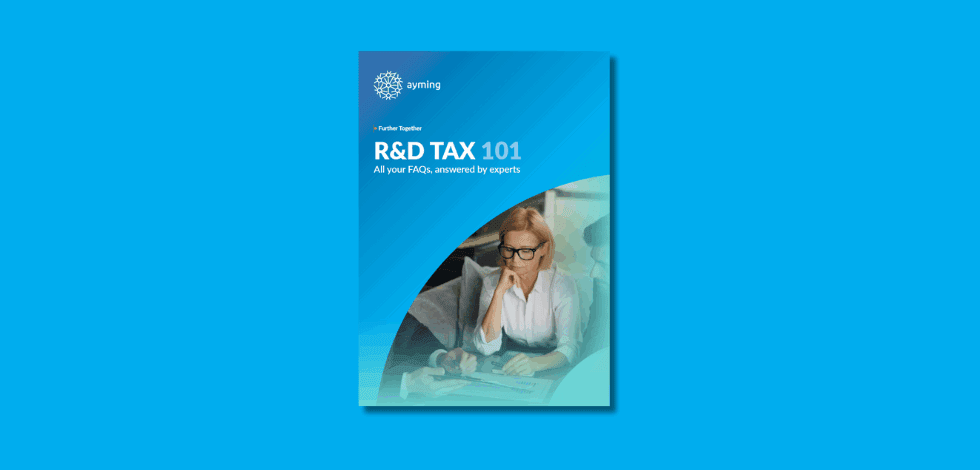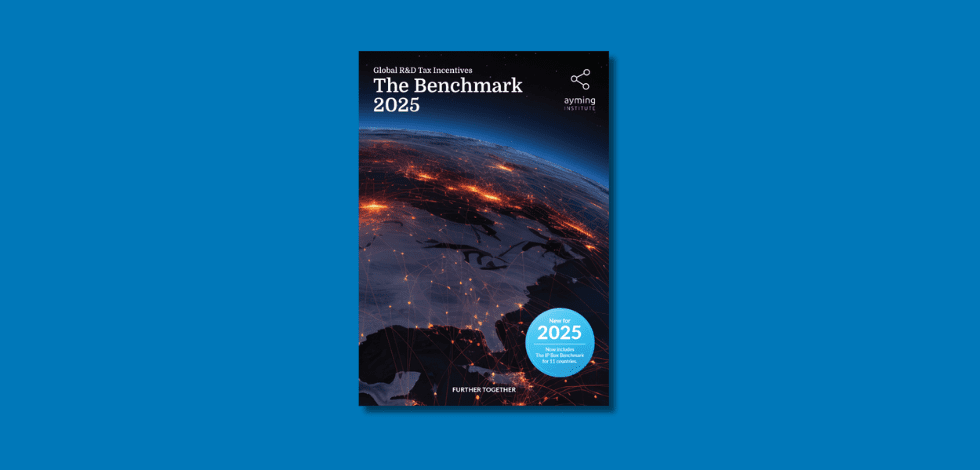What are small business R&D tax credits?
The UK’s Research and Development (R&D) tax credit schemes are designed to reward and incentivise innovation within the UK economy. The UK Government has committed to increasing public investment in R&D, reaching £22 billion per year by 2025. R&D tax credits are a valuable cash injection for companies and can help them hire new people, conduct more R&D activities, and ultimately grow the business.
Innovation is a hugely important driver of long-term economic growth and tackling huge problems society faces, such as climate change. The UK Government has set a target of innovation spending at 2.4% of GDP by 2027, and SMEs are a huge part of this.
Two R&D tax schemes reflect the different needs of SMEs and large companies. The UK’s SME scheme began in 2000, and the large company scheme (Research and Development Expenditure Credit, RDEC) followed two years later, in 2002, for firms that were ineligible for the SME scheme.
The SME R&D tax scheme offers tax benefits through enhanced deductions for qualifying R&D expenditure. Depending on your company’s profit or loss-making position, you can receive a benefit of up to 27% of the qualifying costs. This would give you back 27p for every £1 of qualifying spend. The benefit is either a reduction in corporation tax or a cash credit.
How does the SME R&D tax credit scheme work?
The scope of R&D for tax purposes is much broader than you might think, and not just the proverbial grey-haired white lab-coated scientist. If your company spends money on research, development, or innovation, some of these costs will likely be eligible.
The criteria for research and development in tax terms are:
Seeking an advance in a field of science or technology
There are several ways the activity might meet this criterium:
- Developing something completely new.
- Appreciably improving an existing process or product.
- Duplicating an existing process or product using a different method or material
- Replicating a competitor’s existing process or product, kept as a trade secret.
Attempting to overcome scientific or technological uncertainty whilst seeking your advance;
Uncertainty is the important word here. It must be a problem that your knowledgeable employees could not solve without investigating. This uncertainty could be due to a variety of reasons, including:
- Infrastructural constraints
- Architectural challenges
- Cost constraints
- Industry-related trends, etc.
Failure is part and parcel of R&D, so the project doesn’t have to be successful to be eligible!
The definition of R&D used by the UK government is purposefully broad, as it has to cover all sectors, including construction and engineering, IT and technology, food and beverage, manufacturing, and life sciences. This broad definition means that the scope of qualifying projects and activities is extensive, from new product development and product/process improvement to internal projects such as improvements to sustainability. Often, work that feels routine can meet all the criteria for R&D.
What are the cost categories?
You can claim for qualifying activities in several categories of costs.
Cost categories include:
- Staff time,
- contractors,
- software licences,
- cloud computing,
- datasets,
- pure mathematics,
- consumables,
- and materials.
To claim under the SME scheme, you must first assess activities and costs to determine which qualify. Your tax benefit can then be calculated and submitted alongside the evidence to HMRC, either as a corporate tax reduction or as a request to receive R&D tax credits. On average, it takes approximately 48 days to receive your payment from HMRC once you have submitted it.
Who is eligible for small business R&D credits?
The SME R&D tax scheme targets SMEs that undertake qualifying R&D activity. The UK definition of an SME is a company with:
- Fewer than 500 staff
- Either less than €100 million in turnover OR less than €86 million in gross assets
To be eligible, you also have to be liable for UK corporate tax; you must not have received notified state aid such as grants, and the expenditure you want to claim for must be revenue in nature.
Most UK-operating businesses will fall into this category, including start-ups, and we can see this in the statistics. The SME R&D tax scheme receives more than 52,000 claims each year. Even if you don’t meet the criteria, you might still be able to claim under the large company RDEC scheme instead.
If this is your first claim, you can claim R&D tax relief for your last two completed accounting periods. After two accounting periods, the R&D undertaken can no longer be back claimed, so there’s no time like the present to begin the process of your SME R&D tax claim!
R&D tax credit for start-ups
On average, SMEs claim roughly £60,000 in R&D tax relief. However, more than 50% of UK SMEs, including many start-ups, have not heard of the scheme. The average R&D tax relief claimed for businesses under five years old is roughly £40,000, which can present a hugely valuable source of cash for companies in those difficult first few years.
Typically, a start-up forms to service a market gap or monetise a new idea. These new ideas usually involve developing a process, product, service, or device. In this case, you are likely undertaking R&D in some capacity and could be eligible to claim under the SME R&D tax scheme.
There is a common misconception that start-ups can’t claim R&D Tax Credits because they have very few employees, but staff wages only make up one category of costs!
The investments made in software licences for R&D, materials to create prototypes, and utilities used on your premises are all eligible to be claimed. In the SME scheme, a portion of expenditure on 3rd party R&D work, for example, to a firm with equipment and capabilities that you are yet to have in-house, is eligible to be claimed and can form a significant component of start-up R&D tax credit claims.
You don’t have to be profitable to benefit from R&D tax credits. If you are a loss-making company (as many start-ups are), you receive 27% of your qualifying expenditure back as a tax credit!
What does this mean for SMEs and start-ups?
Your R&D activity must fit HMRC’s definition of seeking an advance in a scientific or technological field and facing uncertainties along the way. It doesn’t have to be cutting-edge research (though it can be!)
People often consider problem-solving activities as ‘business as usual’ when their problems actually feature technological or scientific uncertainties. Therefore, any activity done to find the solution would qualify for R&D tax credits.
In terms of receivable benefit, if you made a profit during the accounting period you’re claiming for, you can claim up to 21.5% of your qualifying R&D expenditure, either to reduce your payable tax or as a cash credit.
Example:
- If you’re profit-making and spent £250,000 of qualifying costs on R&D, you could receive £53,750 in your bank in 35 days.
Likewise, suppose you made a loss during the accounting period for which you’re claiming, and you are not R&D intensive. In this case, you can claim up to 18.6% of your qualifying R&D expenditure as a cash credit, offset against prior or future year’s profits, or surrender it for group relief.
Example:
- If you’re loss-making and spent £250,000 of qualifying costs on R&D, you could offset £46,250 against future years’ profits, reducing your tax payable in that year.
How Ayming can help
Put simply, we use our knowledge and experience to maximise your R&D tax relief claim, ensure it is robust and defensible, and make the whole process as easy for you as possible.
Ayming has dedicated teams of tax and technical experts who understand the intricacies of the R&D tax credit schemes and have a vast range of industry knowledge.
If you have used an advisor previously or claimed in-house, and we feel that you underclaimed in your previous accounting period, we will work to uplift it and get the benefit to which your company is entitled.
We have experts with backgrounds in most sectors, from construction & engineering to life sciences, from food & beverage to software development. We talk to the members of your team carrying out the R&D activities as peers. We use the same technical language and incorporate it into the language of R&D tax writing to make it as understandable as possible to the layperson.
We can also tailor our methodology for gathering qualifying expenditure to best suit your company’s financial data recording and ensure we create the most efficient process for you. We do most of the legwork, leaving you to continue innovating and growing your business.
Ayming will be there throughout the entire R&D tax claims process, and if HMRC has questions or wishes to open an enquiry, we’ll be with you every step of the way to support your claim.
FAQs
Can SMEs claim RDEC?
SMEs usually won’t be able to claim R&D tax credits through the RDEC scheme, however, they can claim through the RDEC scheme if they are subcontracted to do R&D by a large company or if they have received any government grants or funding.
Is there a government grant for SME R&D?
Under the SME R&D tax credit scheme, eligible SMEs can claim up to 18.6% of their qualifying R&D expenditure as a tax credit. Note that the SME R&D tax credit scheme is classified as notifiable state aid.
What evidence do I need to claim through the SME R&D scheme?
To make a claim through the SME R&D scheme, you must submit a completed CT600 form (corporate tax return) and full tax computation that specifies your enhanced expenditure and the intended claim. Failing to include these forms will result in the rejection of your claim.
From 1 August 2023, detailed information was made compulsory through the introduction of the additional information form (AIF). Without the AIF, the claim is invalid. This form includes details of R&D contacts, agents used, details of qualifying expenditure and information about the projects.
To demonstrate a robust R&D claims process and support your R&D tax credit claim, Ayming recommends you provide supplementary technical documentation, also known as a ‘technical narrative.’ This documentation should contain specific details about your R&D projects (inclusive of challenges, individuals involved, resources utilised, and outcomes achieved.)
Including this information will not only strengthen your claim, but it will also show HMRC that you have a meticulous and detailed procedure in place, thereby reducing the risk of any potential penalties.
Is there a cap on R&D tax claims for SMEs?
Introduced on 1st April 2021, SMEs can only claim a payable tax credit that’s up to 300% of their combined PAYE and NIC liabilities, with an additional buffer of £20,000.
Can startups claim R&D tax credits?
The R&D tax credit scheme is inclusive and designed to benefit all types of businesses, regardless of whether they operate at a profit or a loss. Companies that are profitable benefit by paying less tax on their taxable profit, while companies operating at a loss can either surrender the loss generated through the SME R&D tax credit scheme for cash or carry it over.
The cash payment represents around 10% of your business’s enhanced expenditure, which is approximately 18.6% of your total qualifying expenditure. To work out how much your loss-making business is entitled to under the SME scheme, you will need to perform the following calculations:
- Eligible expenditure x enhancement rate (86%) = total enhancement figure
- Eligible expenditure + total enhancement figure = Enhanced expenditure
- Enhanced expenditure x surrender rate (10%) = Tax credit amount












